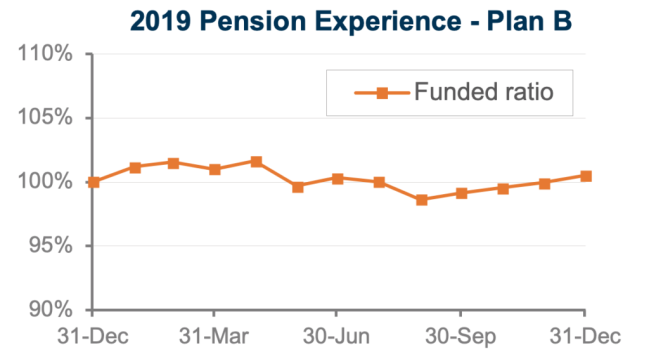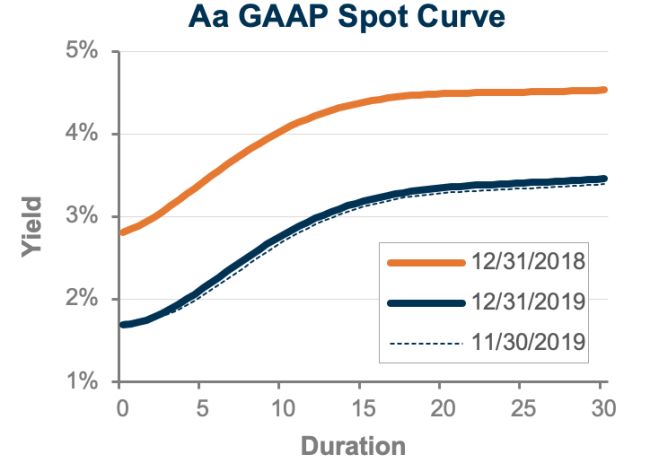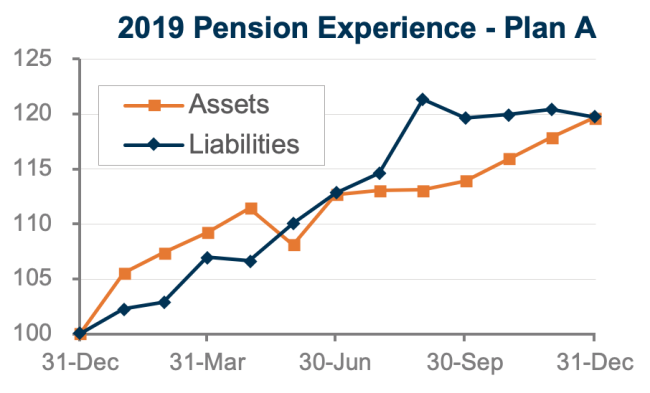December 2019 Pension Finance Update
2019 was the best of times, then the worst of times, then the best of times again for pension finance. Overall assessment: meh. During December, both model plans we track[1] gained ground for the fourth consecutive month: Plan A improved 2% and finished 2019 even, while Plan B gained less than 1%, ending 2019 up less than 1%:


Assets
Stocks gained 3% again in December, finishing 2019 with an eye-popping return of 27.5%, led by US stocks generally and NASDAQ in particular:

Treasury rates jumped 0.15% in December, while corporate bond yields rose less than 0.1%, as credit spreads tightened to their narrowest this century. As a result, bonds lost almost 1% last month, but posted strong returns for 2019 overall, gaining 10%-16%, with long duration and corporate bonds performing best.
Overall, our traditional 60/40 portfolio gained more than 1% during December and 20% for the year, while the conservative 20/80 portfolio was flat last month but earned 16% overall in 2019.
Liabilities
Pension liabilities (for funding, accounting, and de-risking purposes) are driven by market interest rates. The first graph below compares our Aa GAAP spot yield curve at December 31, 2018 and December 31, 2019, and it also shows the (small) movement in the curve last month. The second graph below shows our estimate of movements in effective GAAP discount rates for pension obligations of various duration during 2019:


Corporate bond yields moved up more than 0.05% in December. As a result, pension liabilities fell almost 1% during the month, ending 2019 14%-23% higher, with long duration plans seeing the largest increases.
Summary
Higher stock prices improved pension finances during the first four months of the year, then stocks and interest rates plunged between May and August, leaving sponsors in a hole by Labor Day, before stocks and rates pushed higher again in the last four months of the year. Like a roller coaster, 2019 had lots of ups and downs for pension finance, but we ended the year about where we began. The graphs below show the progress of assets and liabilities for our two model plans during 2019:


Looking Ahead
Pension funding relief has reduced required plan funding since 2012, but under current law, this relief will gradually sunset. Given the current level of market interest rates, it is possible that relief reduces the funding burden through 2028, but the rates used to measure liabilities will move significantly lower over the next few years, increasing funding requirements for pension sponsors that have only made required contributions.
Discount rates edged up a bit last month. We expect most pension sponsors will use effective discount rates in the 3.0%-3.4% range to measure pension liabilities right now, a full percent lower than rates at the end of 2018.
The table below summarizes rates that plan sponsors are required to use for IRS funding purposes for 2019, along with estimates for 2020. Pre-relief, both 24-month averages and December ‘spot’ rates, which are still required for some calculations, such as PBGC premiums, are also included.

[1] Plan A is a traditional plan (duration 12 at 5.5%) with a 60/40 asset allocation, while Plan B is a largely retired plan (duration 9 at 5.5%) with a 20/80 allocation with a greater emphasis on corporate and long-duration bonds. We assume overhead expenses of 1% of plan assets per year, and we assume the plans are 100% funded at the beginning of the year and ignore benefit accruals, contributions, and benefit payments in order to isolate the financial performance of plan assets versus liabilities.
